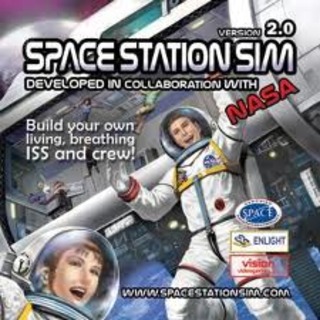Want to build your version of the International Space Station? This great value and innovative game lets you do it!
Initially, you start in Mission Control with a bank of desks on the screen (this is a representation of the ISS control room). Each desk controls a different aspect of station operations: Resupply, new modules, astronaut selection, etc. On average I spend about a third to half of my game time navigating round different screens in this area. Each action you carry out, such as sending an ESA Automated Transfer Vehicle to resupply the station, is accompanied by a nice movie graphic. Clicking on the main screen at the far end of the room takes you into space, to see and interact with your station. You start with just one module in space, the Russian Zvezda habitation and control module. One cosmonaut will also be up there, in his bunk, sleeping soundly. The first order of business is to get the CO2 scrubbers and contaminant filters turned on. Once this is done check to see which launch vehicles are available for launching new equipment (Russian Soyuz, Proton and Progress, NASA's Shuttle, ESA's Ariane 5 or JAXA's H-2). The astronauts and cosmonauts are under a combination of AI control and user control; they will obey your commands, but if left alone will generally do housekeeping chores aboard the station.
Once you get a couple of modules in space (its usually easier first time round to try to build the ISS as it is in real life) its time to launch your first laboratory module. The American Destiny lab is a good starting point as it has connecting docking ports at both ends, has a large number of spaces for science racks, and is designed to accept the keel structure for putting on the big solar panels that will eventually provide power and thermal control. Once Destiny is in space, you can start filling it with experiment racks using your launch vehicles, and get your astronauts to conduct the experiments, thereby generating 'flags' (in lieu of money) for the various nations sponsoring the experiments. This in turn gives you the ability to launch further modules and experiments.
From then on the game is all about expanding your station and keeping it flying!
Graphically the game is interesting. There is a slightly cartoony style to it, meshed with lovely 3D models which cutaway to reveal the inside of the station. The gameplay is fun and largely intuitive, and, once you have climbed the learning curve, quite satisfying. The trick to keeping the game fresh is to start each station with a different idea of what sort of station you want to end up with, rather than trying to finish the game each time! (I managed to build one station which from a distance looked remarkably like a Nebulon-B frigate from Star Wars!) The sound is once of my favourite parts of the game, with different tunes and songs being played as you move around the station. Overall, its great value for money and an innovative game.

